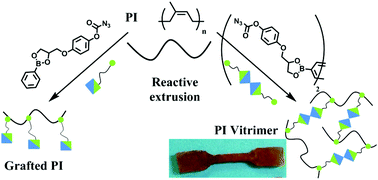Functionalization of polyisoprene and polystyrene via reactive processing using azidoformate grafting agents, and its application to the synthesis of dioxaborolane-based polyisoprene vitrimers†
Abstract
Vitrimers incorporating dioxaborolane covalent links are permanent polymeric networks that combine the processability of thermoplastics with the thermomechanical and chemical resistance of thermosets. Transforming existing polymers into vitrimers via melt processing, a green and economical process, is a significant challenge that would greatly facilitate the development of these materials. In this study, we investigate the potential of azidoformate derivatives to functionalize and/or crosslink diene- and vinyl-based polymers with dioxaborolane moieties. To this aim, two functional azidoformate grafting agents were prepared, and their efficiency to functionalize polystyrene and polyisoprene via compression molding and reactive extrusion was assessed. Grafting yields superior to 50 and 75% could be obtained for polystyrene and polyisoprene, respectively. Polyisoprene was then transformed into a vitrimer by reactive extrusion, eitheir in the presence of a mono-azidoformate dioxaborolane and subsequent crosslinking with a bis-dioxaborolane, or in a single step using a bis-azidoformate dioxaborolane crosslinker. In particular, the latter appraoch allowed preparation of vitrimers that relax stress at elevated temperatures, show excellent creep resistance at room temperature and present good mechanical properties. While highly insoluble in THF, these vitrimers could be entirely de-crosslinked by selective diolysis of the dynamic dioxaborolane crosslinks, opening a simple and efficient route to chemical recycling of polyisoprene elastomers. The mechanical recycling of these vitrimers was also investigated over multiple cycles. Polyisoprene vitrimers could be efficiently recycled once, but their mechanical properties significantly dropped after the first recycling cycle, due to the oxidative degradation of the polyisoprene chains during reprocessing.

- This article is part of the themed collection: Chemistry for Covalent Adaptable Polymer Networks


 Please wait while we load your content...
Please wait while we load your content...